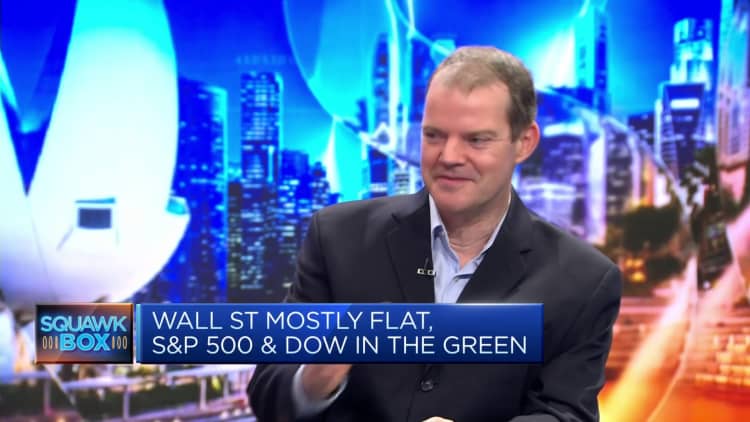A screen displays stock figures at the Taiwan Stock Exchange Corp. headquarters in Taipei, Taiwan, on Monday, Jan. 15, 2024.
Bloomberg | Bloomberg | Getty Images
Optimism in artificial intelligence drove up Taiwan’s stock market in the first of the 2024, making it the top performing market in Asia-Pacific so far this year.
The Taiwan Weighted Index has surged 28% so far this year, powered by stocks along the AI value chain.
Heavyweight Taiwan Semiconductor Manufacturing Corp climbed 63% in the first half of the year, while its rival Foxconn — traded as Hon Hai Precision Industry — jumped 105% in the same period.
“The performance of global markets this year has been largely driven by the themes of Artificial Intelligence and central bank policy, and that is likely to continue,” said Rahul Ghosh, global equity portfolio specialist at asset management company T. Rowe Price said in the firm’s investment outlook.
The potential and scale of the AI investment cycle continues to drive economic activity globally, he said, adding that the impact of AI investments are broadening out to sectors such as industrials, materials and utilities.
Japan’s benchmark index Nikkei 225 ranked second in the region, after repeatedly surpassing all-time highs earlier this year. In the first six months of the year, the Nikkei has gained about 18%.
The Nikkei smashed past a 34-year record in February, breaching its previous all-time high of 38,915.87, set on Dec. 29, 1989.
Following that, the index surged past the psychological threshold of 40,000, and eventually reached a new all-time closing high of 40,888.43 on March 22.
While Taiwan may lead Asian markets, Japan seems to be the favored market going forward, among analysts who spoke to CNBC.

Ghosh said that improved corporate governance standards continue to have a tangible — and considerable — impact on company performance in the world’s fourth largest economy.
Furthermore, a June 14 note from Ben Powell, chief APAC investment strategist at the BlackRock Investment Institute, pointed out that the Bank of Japan has increasing confidence it will meet its inflation targets, and as such, normalize its monetary policy “in a gradual and measured way.”
Powell said Japan’s macroeconomic backdrop is favorable for risk assets. “We remain overweight Japanese equities, driven by strong corporate reform momentum, healthy earnings and the valuation support from still-negative real interest rates.”
While most Asian markets are in positive territory year-to-date, three stock markets — Thailand, Indonesia and the Philippines — fell into negative territory.
Thailand’s SET Index plunged 8% in the first six months, to be the worst performing index in the region. The Jakarta Composite was down by 2.88% while the Philippine stock exchange index slipped about 0.6% in the same period.
All eyes on the Fed
Most central banks in Asia are keeping a close eye on the Federal Reserve’s next move, as they typically make monetary policy decisions based on the U.S. central bank’s anticipated moves.
The Fed signaled toward the end of 2023 that several rate cuts were on the cards this year.
The dot plot is a visual representation of each FOMC member’s interest rate projection for the bank’s short-term interest rate at specific points in the future.
The central bank, however, has penciled in a more aggressive path to tightening monetary policy in 2025, increasing its forecast to four cuts of 25 basis points each.

Rate cut expectations have been pushed back repeatedly as inflation remained stickier than expected. Higher employment and wage growth in the U.S. also added to the narrative that there was no need for the Fed to lower rates.
The question now is: When will the first rate cut happen?
The CME FedWatch tool indicates that 61% of traders expect the Fed to cut rates by 25 basis points in the September meeting.
But on June 16, Minneapolis Federal Reserve President Neel Kashkari said it’s a “reasonable prediction” that the U.S. central bank will cut interest rates once this year, but will wait until December to do it.
Kashkari’s view was echoed by Ken Orchard, head of international fixed income at asset management firm T. Rowe Price.
“We still see the Fed cutting 25 basis points at its December policy meeting, after the November elections are out of the way, and possibly once in the summer.”

However, he predicted that the central bank will enact fewer cuts in 2025 than the dot plot suggests, calling the 2025 outlook “murkier” than this year.
“One or two rate reductions next year seems more realistic,” Orchard said, warning that there’s a chance the Fed might even raise borrowing costs next year.
“There is a risk that insurance cuts by the Fed could allow inflation to fester and raise the chances of moving back to a hiking bias in 2025.”
Homin Lee, senior macro strategist at Swiss private bank Lombard Odier, appeared more optimistic, telling CNBC that his base case is two cuts in the second half of 2024.
That’s one less than the three cuts the bank had predicted in its May 9 outlook report, before the Fed’s revised dot plot.
“That said, we are still confident that rate cuts will begin in September, given the Fed’s ‘asymmetric’ stance, i.e. hurdle for renewed tightening is extremely high whereas the hurdle for the start of rate cuts is much lower,” Lee added.

